BTEC HND Unit 09: Software Development Life Cycle Analysis and Design
VerifiedAdded on 2023/01/17
|37
|6860
|51
Report
AI Summary
This report undertakes a comprehensive analysis and design of the Software Development Life Cycle (SDLC) for the Tune Source project. It begins with an identification of stakeholders, their roles, and requirements, distinguishing between functional and non-functional requirements, and explores techniques for requirements elicitation such as interviews and JAD sessions. The report then delves into requirement modeling using structural and behavioral techniques, including Use Case Diagrams, Data Flow Diagrams, and ERDs. The design phase is discussed, addressing user and software requirements through mock-ups and wireframes, and proposing a suitable architecture and technical stack. The report also examines software behavior specification using activity diagrams, pseudocode, and UML state machines, differentiating between FSM and extended FSM. Finally, it addresses software quality management by discussing relevant quality attributes, assurance techniques, and the impact of design techniques on software quality. This assignment provides a complete SDLC analysis and design for the Tune Source project.

Paraphrase This Document
Need a fresh take? Get an instant paraphrase of this document with our AI Paraphraser
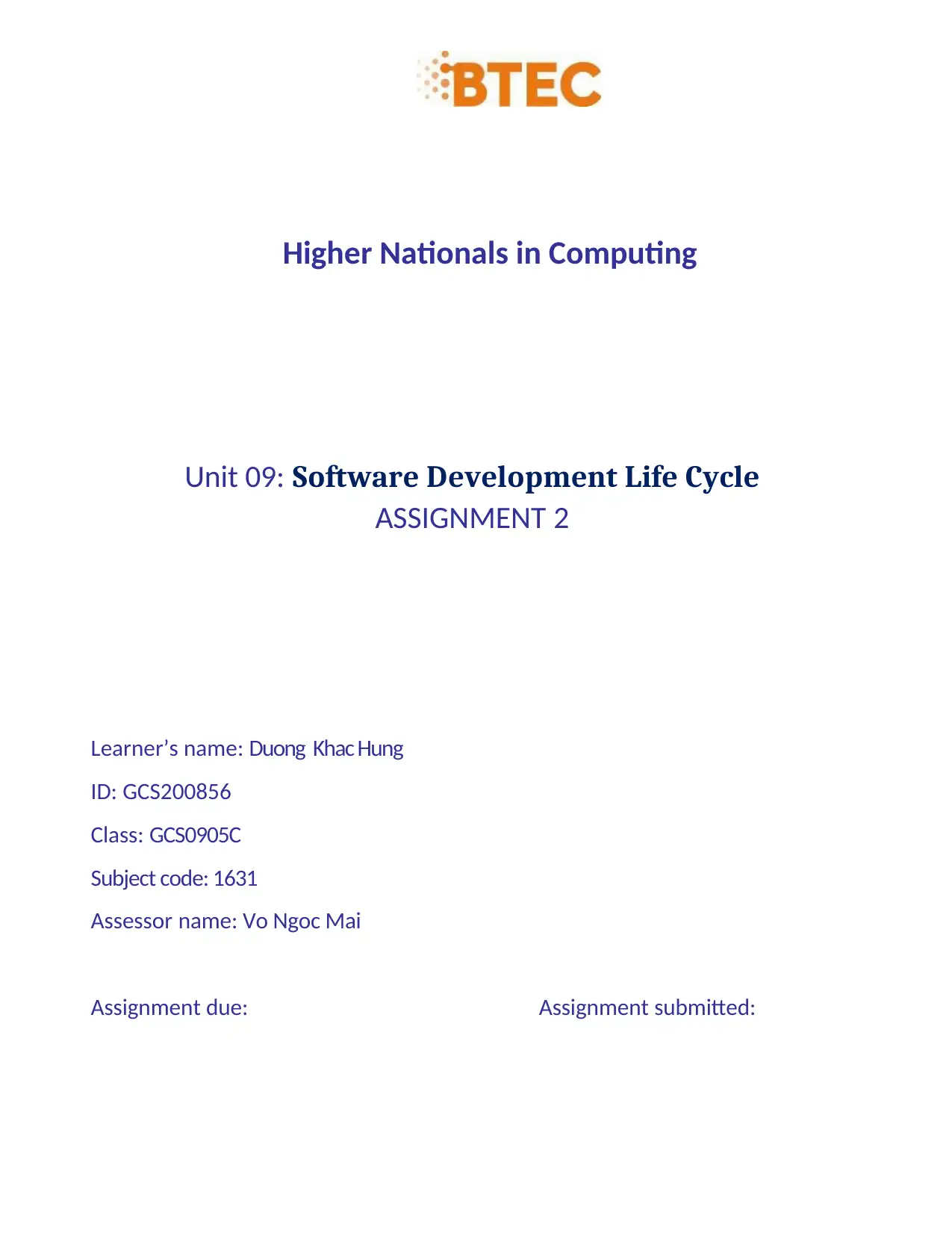
Higher Nationals in Computing
Unit 09: Software Development Life Cycle
ASSIGNMENT 2
Learner’s name: Duong Khac Hung
ID: GCS200856
Class: GCS0905C
Subject code: 1631
Assessor name: Vo Ngoc Mai
Assignment due: Assignment submitted:
Unit 09: Software Development Life Cycle
ASSIGNMENT 2
Learner’s name: Duong Khac Hung
ID: GCS200856
Class: GCS0905C
Subject code: 1631
Assessor name: Vo Ngoc Mai
Assignment due: Assignment submitted:
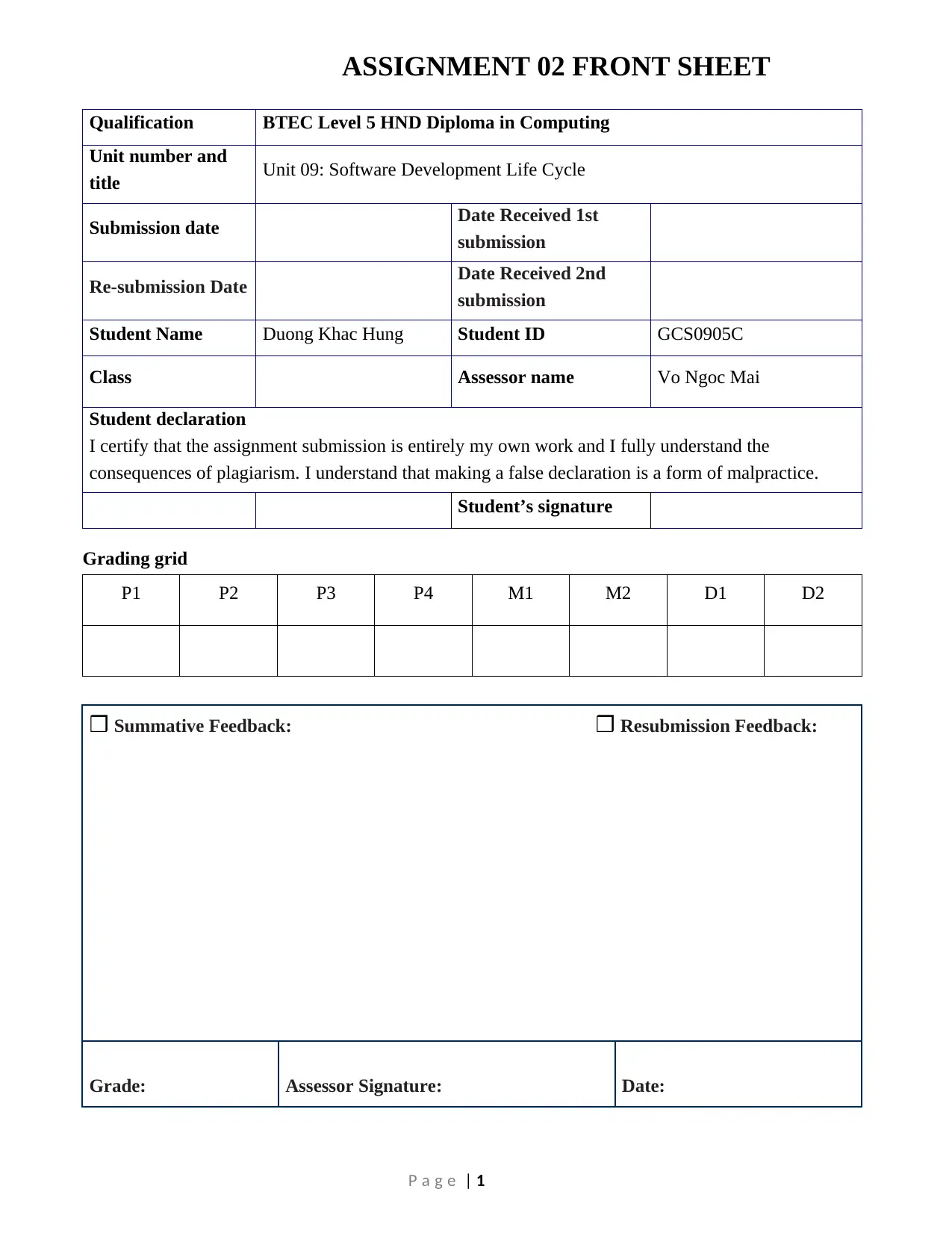
ASSIGNMENT 02 FRONT SHEET
Qualification BTEC Level 5 HND Diploma in Computing
Unit number and
title Unit 09: Software Development Life Cycle
Submission date Date Received 1st
submission
Re-submission Date Date Received 2nd
submission
Student Name Duong Khac Hung Student ID GCS0905C
Class Assessor name Vo Ngoc Mai
Student declaration
I certify that the assignment submission is entirely my own work and I fully understand the
consequences of plagiarism. I understand that making a false declaration is a form of malpractice.
Student’s signature
Grading grid
P1 P2 P3 P4 M1 M2 D1 D2
❒ Summative Feedback: ❒ Resubmission Feedback:
Grade: Assessor Signature: Date:
P a g e | 1
Qualification BTEC Level 5 HND Diploma in Computing
Unit number and
title Unit 09: Software Development Life Cycle
Submission date Date Received 1st
submission
Re-submission Date Date Received 2nd
submission
Student Name Duong Khac Hung Student ID GCS0905C
Class Assessor name Vo Ngoc Mai
Student declaration
I certify that the assignment submission is entirely my own work and I fully understand the
consequences of plagiarism. I understand that making a false declaration is a form of malpractice.
Student’s signature
Grading grid
P1 P2 P3 P4 M1 M2 D1 D2
❒ Summative Feedback: ❒ Resubmission Feedback:
Grade: Assessor Signature: Date:
P a g e | 1
⊘ This is a preview!⊘
Do you want full access?
Subscribe today to unlock all pages.

Trusted by 1+ million students worldwide

Internal Verifier’s Comments:
Signature & Date:
Assignment Brief 02 (RQF)
Higher National Certificate/Diploma in Business
Student Name/ID Number:
Unit Number and Title: Unit 09: Software Development Life Cycle
Academic Year:
Unit Assessor:
Assignment Title: Undertake a software development life cycle
Issue Date: 07/12/2020
Submission Date:
Internal Verifier Name:
Date:
Submission Format:
Format:
● The submission is in the form of 1 document.
● You must use the Times font with 12pt size, turn on page numbering; set line spacing to 1.3 and
margins to be as follows: left = 1.25cm, right = 1cm, top = 1cm, bottom = 1cm. Citation and references
must follow the Harvard referencing style.
Submission:
P a g e | 2
Signature & Date:
Assignment Brief 02 (RQF)
Higher National Certificate/Diploma in Business
Student Name/ID Number:
Unit Number and Title: Unit 09: Software Development Life Cycle
Academic Year:
Unit Assessor:
Assignment Title: Undertake a software development life cycle
Issue Date: 07/12/2020
Submission Date:
Internal Verifier Name:
Date:
Submission Format:
Format:
● The submission is in the form of 1 document.
● You must use the Times font with 12pt size, turn on page numbering; set line spacing to 1.3 and
margins to be as follows: left = 1.25cm, right = 1cm, top = 1cm, bottom = 1cm. Citation and references
must follow the Harvard referencing style.
Submission:
P a g e | 2
Paraphrase This Document
Need a fresh take? Get an instant paraphrase of this document with our AI Paraphraser
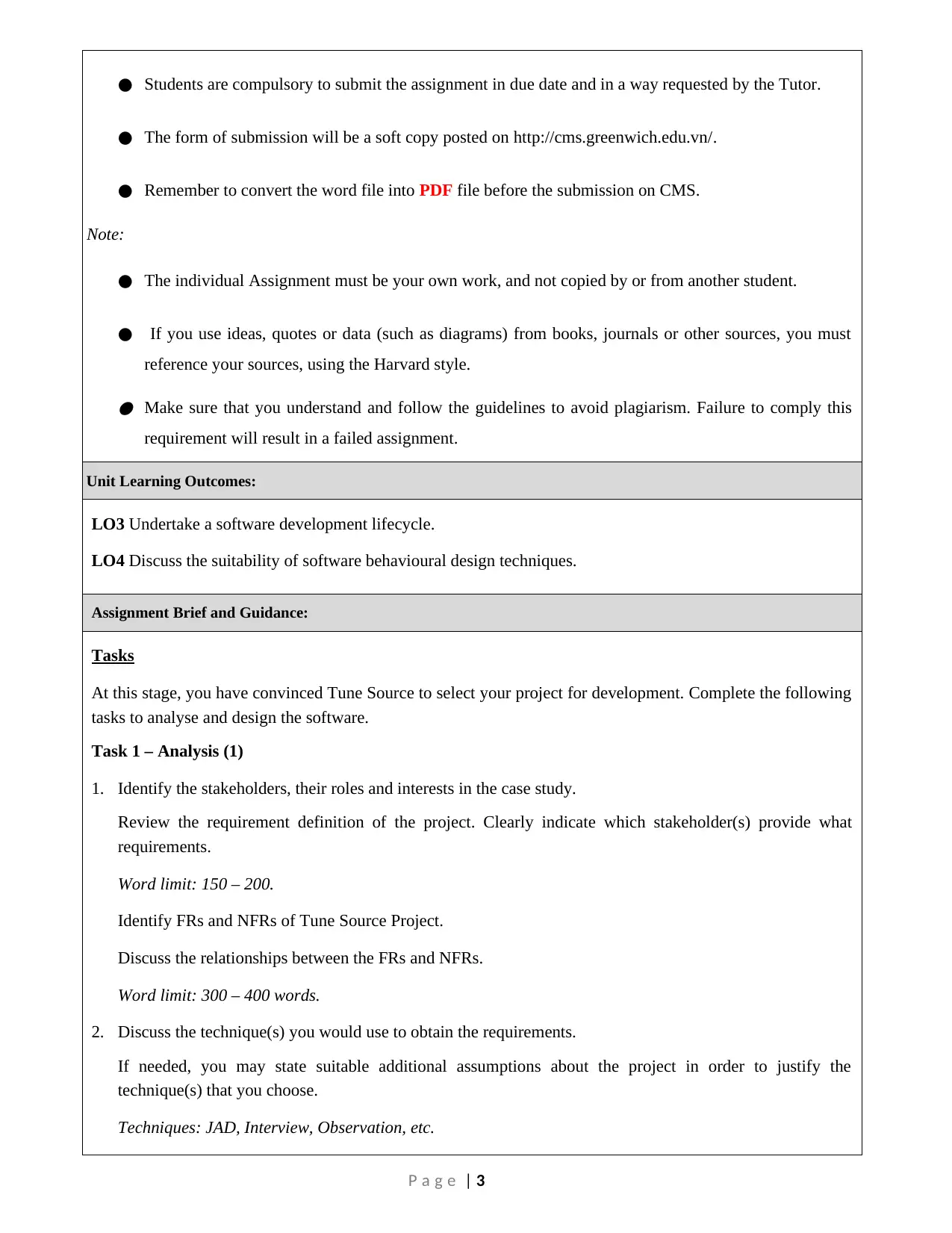
● Students are compulsory to submit the assignment in due date and in a way requested by the Tutor.
● The form of submission will be a soft copy posted on http://cms.greenwich.edu.vn/.
● Remember to convert the word file into PDF file before the submission on CMS.
Note:
● The individual Assignment must be your own work, and not copied by or from another student.
● If you use ideas, quotes or data (such as diagrams) from books, journals or other sources, you must
reference your sources, using the Harvard style.
● Make sure that you understand and follow the guidelines to avoid plagiarism. Failure to comply this
requirement will result in a failed assignment.
Unit Learning Outcomes:
LO3 Undertake a software development lifecycle.
LO4 Discuss the suitability of software behavioural design techniques.
Assignment Brief and Guidance:
Tasks
At this stage, you have convinced Tune Source to select your project for development. Complete the following
tasks to analyse and design the software.
Task 1 – Analysis (1)
1. Identify the stakeholders, their roles and interests in the case study.
Review the requirement definition of the project. Clearly indicate which stakeholder(s) provide what
requirements.
Word limit: 150 – 200.
Identify FRs and NFRs of Tune Source Project.
Discuss the relationships between the FRs and NFRs.
Word limit: 300 – 400 words.
2. Discuss the technique(s) you would use to obtain the requirements.
If needed, you may state suitable additional assumptions about the project in order to justify the
technique(s) that you choose.
Techniques: JAD, Interview, Observation, etc.
P a g e | 3
● The form of submission will be a soft copy posted on http://cms.greenwich.edu.vn/.
● Remember to convert the word file into PDF file before the submission on CMS.
Note:
● The individual Assignment must be your own work, and not copied by or from another student.
● If you use ideas, quotes or data (such as diagrams) from books, journals or other sources, you must
reference your sources, using the Harvard style.
● Make sure that you understand and follow the guidelines to avoid plagiarism. Failure to comply this
requirement will result in a failed assignment.
Unit Learning Outcomes:
LO3 Undertake a software development lifecycle.
LO4 Discuss the suitability of software behavioural design techniques.
Assignment Brief and Guidance:
Tasks
At this stage, you have convinced Tune Source to select your project for development. Complete the following
tasks to analyse and design the software.
Task 1 – Analysis (1)
1. Identify the stakeholders, their roles and interests in the case study.
Review the requirement definition of the project. Clearly indicate which stakeholder(s) provide what
requirements.
Word limit: 150 – 200.
Identify FRs and NFRs of Tune Source Project.
Discuss the relationships between the FRs and NFRs.
Word limit: 300 – 400 words.
2. Discuss the technique(s) you would use to obtain the requirements.
If needed, you may state suitable additional assumptions about the project in order to justify the
technique(s) that you choose.
Techniques: JAD, Interview, Observation, etc.
P a g e | 3

Demonstrate how to collect requirements based on chosen technique.
Word limit: 700 – 1000.
3. Discuss how you would trace these requirements throughout the project by using Requirement Traceability
matrix. You will have to provide real usage of it.
Word limit: 400 – 500 words.
Task 2 – Analysis (2)
Analyze the requirements that you identified in Task 1 using a combination of structural and behavioral
modelling techniques that you have learnt.
Scope: You only need to construct following items for the system. You will have to include:
Use Case Diagram for the whole system.
Use Case specification for 2 Use cases.
Context Diagram for the whole system.
Data Flow Diagram – Level 0 for the whole system.
ERD for the whole system.
For each diagram, you will have to explain properly.
Word limit: 1000 – 1200 words.
Task 3 – Design
Based on the analysis result, discuss how you would conduct the design phase:
1. Discuss how the user and software requirements are addressed in the design phase.
You will explain how Mock-up, and Wireframe are used in the project. You should include some of
the mockup or wireframe (at least 5) design of the Tune Source project to justify that it matches users’
requirements.
You will explain which architecture (client – server, n-tier, microservices, etc.) is suitable for the
project with clear illustrations and why.
Then you will address which technical solution stack could be suitable to implement the project with
clear explanations.
2. Discuss how activity diagram and pseudocode are used to specify the software behaviour.
3. Discuss how UML state machine can be used to specify the software behaviour. Differentiate between
FSM and extended FSM using the case study.
4. Discuss how the data-driven approach improves the reliability and effectiveness of software.
Word limit: 800 – 1500.
Task 4 – Software quality management
1. Discuss two software quality attributes that are applicable to the project.
2. Discuss two quality assurance techniques that can help improve the software quality in the project.
3. Discuss how the design techniques and approaches that you have used can help improve the software
P a g e | 4
Word limit: 700 – 1000.
3. Discuss how you would trace these requirements throughout the project by using Requirement Traceability
matrix. You will have to provide real usage of it.
Word limit: 400 – 500 words.
Task 2 – Analysis (2)
Analyze the requirements that you identified in Task 1 using a combination of structural and behavioral
modelling techniques that you have learnt.
Scope: You only need to construct following items for the system. You will have to include:
Use Case Diagram for the whole system.
Use Case specification for 2 Use cases.
Context Diagram for the whole system.
Data Flow Diagram – Level 0 for the whole system.
ERD for the whole system.
For each diagram, you will have to explain properly.
Word limit: 1000 – 1200 words.
Task 3 – Design
Based on the analysis result, discuss how you would conduct the design phase:
1. Discuss how the user and software requirements are addressed in the design phase.
You will explain how Mock-up, and Wireframe are used in the project. You should include some of
the mockup or wireframe (at least 5) design of the Tune Source project to justify that it matches users’
requirements.
You will explain which architecture (client – server, n-tier, microservices, etc.) is suitable for the
project with clear illustrations and why.
Then you will address which technical solution stack could be suitable to implement the project with
clear explanations.
2. Discuss how activity diagram and pseudocode are used to specify the software behaviour.
3. Discuss how UML state machine can be used to specify the software behaviour. Differentiate between
FSM and extended FSM using the case study.
4. Discuss how the data-driven approach improves the reliability and effectiveness of software.
Word limit: 800 – 1500.
Task 4 – Software quality management
1. Discuss two software quality attributes that are applicable to the project.
2. Discuss two quality assurance techniques that can help improve the software quality in the project.
3. Discuss how the design techniques and approaches that you have used can help improve the software
P a g e | 4
⊘ This is a preview!⊘
Do you want full access?
Subscribe today to unlock all pages.

Trusted by 1+ million students worldwide
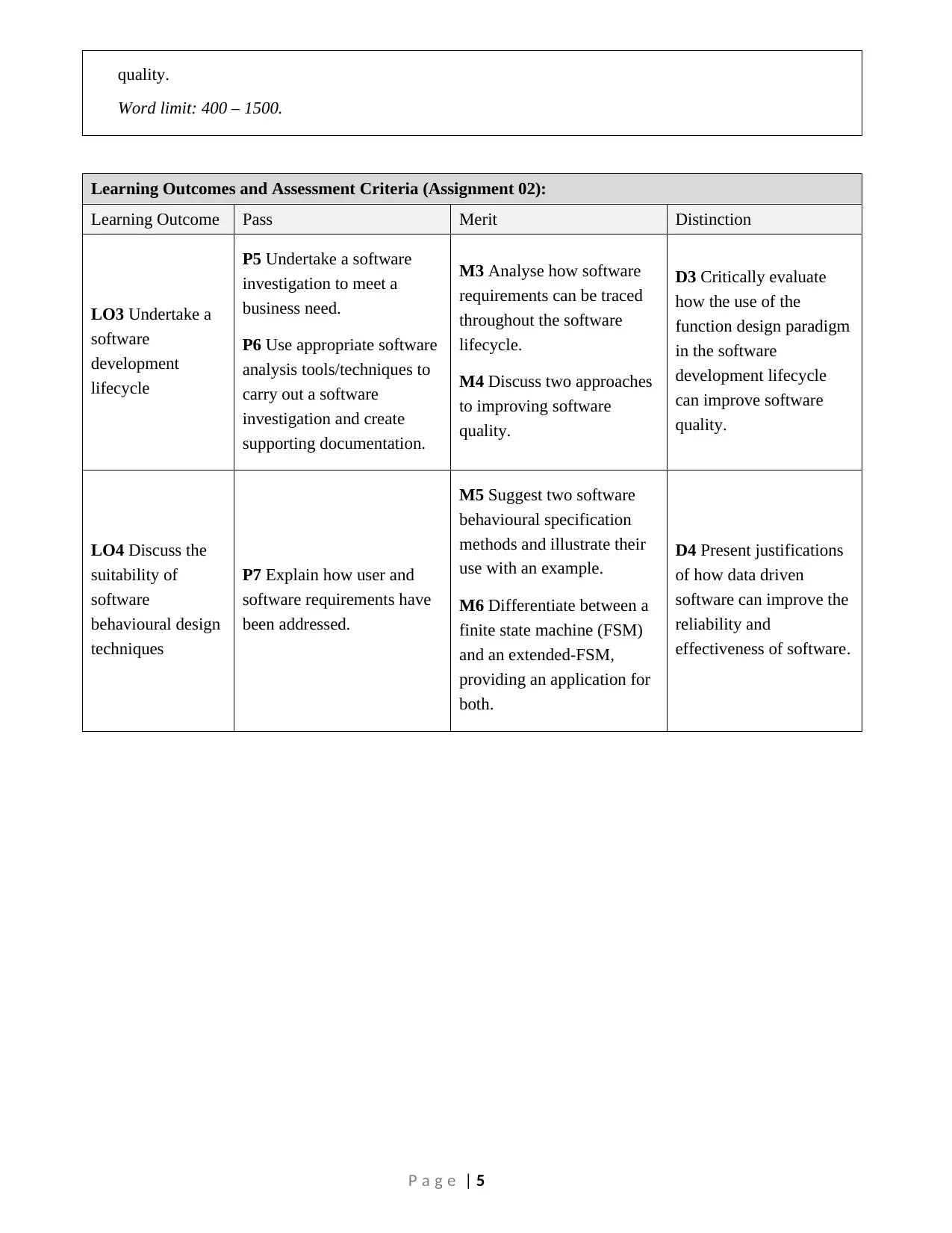
quality.
Word limit: 400 – 1500.
Learning Outcomes and Assessment Criteria (Assignment 02):
Learning Outcome Pass Merit Distinction
LO3 Undertake a
software
development
lifecycle
P5 Undertake a software
investigation to meet a
business need.
P6 Use appropriate software
analysis tools/techniques to
carry out a software
investigation and create
supporting documentation.
M3 Analyse how software
requirements can be traced
throughout the software
lifecycle.
M4 Discuss two approaches
to improving software
quality.
D3 Critically evaluate
how the use of the
function design paradigm
in the software
development lifecycle
can improve software
quality.
LO4 Discuss the
suitability of
software
behavioural design
techniques
P7 Explain how user and
software requirements have
been addressed.
M5 Suggest two software
behavioural specification
methods and illustrate their
use with an example.
M6 Differentiate between a
finite state machine (FSM)
and an extended-FSM,
providing an application for
both.
D4 Present justifications
of how data driven
software can improve the
reliability and
effectiveness of software.
P a g e | 5
Word limit: 400 – 1500.
Learning Outcomes and Assessment Criteria (Assignment 02):
Learning Outcome Pass Merit Distinction
LO3 Undertake a
software
development
lifecycle
P5 Undertake a software
investigation to meet a
business need.
P6 Use appropriate software
analysis tools/techniques to
carry out a software
investigation and create
supporting documentation.
M3 Analyse how software
requirements can be traced
throughout the software
lifecycle.
M4 Discuss two approaches
to improving software
quality.
D3 Critically evaluate
how the use of the
function design paradigm
in the software
development lifecycle
can improve software
quality.
LO4 Discuss the
suitability of
software
behavioural design
techniques
P7 Explain how user and
software requirements have
been addressed.
M5 Suggest two software
behavioural specification
methods and illustrate their
use with an example.
M6 Differentiate between a
finite state machine (FSM)
and an extended-FSM,
providing an application for
both.
D4 Present justifications
of how data driven
software can improve the
reliability and
effectiveness of software.
P a g e | 5
Paraphrase This Document
Need a fresh take? Get an instant paraphrase of this document with our AI Paraphraser
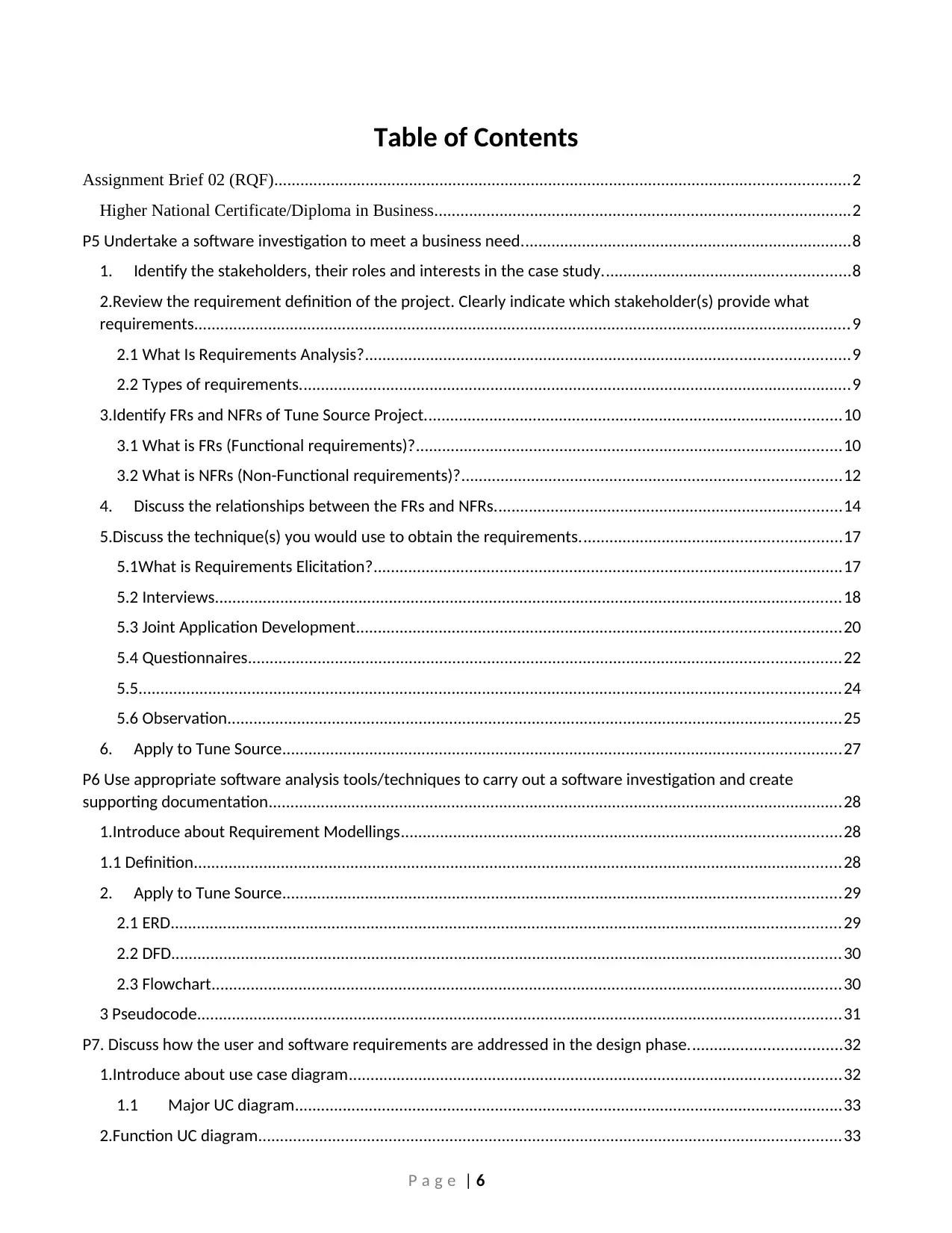
Table of Contents
Assignment Brief 02 (RQF)....................................................................................................................................2
Higher National Certificate/Diploma in Business................................................................................................2
P5 Undertake a software investigation to meet a business need............................................................................8
1. Identify the stakeholders, their roles and interests in the case study.........................................................8
2.Review the requirement definition of the project. Clearly indicate which stakeholder(s) provide what
requirements.......................................................................................................................................................9
2.1 What Is Requirements Analysis?...............................................................................................................9
2.2 Types of requirements...............................................................................................................................9
3.Identify FRs and NFRs of Tune Source Project................................................................................................10
3.1 What is FRs (Functional requirements)?..................................................................................................10
3.2 What is NFRs (Non-Functional requirements)?.......................................................................................12
4. Discuss the relationships between the FRs and NFRs................................................................................14
5.Discuss the technique(s) you would use to obtain the requirements............................................................17
5.1What is Requirements Elicitation?............................................................................................................17
5.2 Interviews................................................................................................................................................18
5.3 Joint Application Development...............................................................................................................20
5.4 Questionnaires........................................................................................................................................22
5.5.................................................................................................................................................................24
5.6 Observation.............................................................................................................................................25
6. Apply to Tune Source................................................................................................................................27
P6 Use appropriate software analysis tools/techniques to carry out a software investigation and create
supporting documentation....................................................................................................................................28
1.Introduce about Requirement Modellings.....................................................................................................28
1.1 Definition.....................................................................................................................................................28
2. Apply to Tune Source................................................................................................................................29
2.1 ERD..........................................................................................................................................................29
2.2 DFD..........................................................................................................................................................30
2.3 Flowchart.................................................................................................................................................30
3 Pseudocode....................................................................................................................................................31
P7. Discuss how the user and software requirements are addressed in the design phase...................................32
1.Introduce about use case diagram.................................................................................................................32
1.1 Major UC diagram..............................................................................................................................33
2.Function UC diagram......................................................................................................................................33
P a g e | 6
Assignment Brief 02 (RQF)....................................................................................................................................2
Higher National Certificate/Diploma in Business................................................................................................2
P5 Undertake a software investigation to meet a business need............................................................................8
1. Identify the stakeholders, their roles and interests in the case study.........................................................8
2.Review the requirement definition of the project. Clearly indicate which stakeholder(s) provide what
requirements.......................................................................................................................................................9
2.1 What Is Requirements Analysis?...............................................................................................................9
2.2 Types of requirements...............................................................................................................................9
3.Identify FRs and NFRs of Tune Source Project................................................................................................10
3.1 What is FRs (Functional requirements)?..................................................................................................10
3.2 What is NFRs (Non-Functional requirements)?.......................................................................................12
4. Discuss the relationships between the FRs and NFRs................................................................................14
5.Discuss the technique(s) you would use to obtain the requirements............................................................17
5.1What is Requirements Elicitation?............................................................................................................17
5.2 Interviews................................................................................................................................................18
5.3 Joint Application Development...............................................................................................................20
5.4 Questionnaires........................................................................................................................................22
5.5.................................................................................................................................................................24
5.6 Observation.............................................................................................................................................25
6. Apply to Tune Source................................................................................................................................27
P6 Use appropriate software analysis tools/techniques to carry out a software investigation and create
supporting documentation....................................................................................................................................28
1.Introduce about Requirement Modellings.....................................................................................................28
1.1 Definition.....................................................................................................................................................28
2. Apply to Tune Source................................................................................................................................29
2.1 ERD..........................................................................................................................................................29
2.2 DFD..........................................................................................................................................................30
2.3 Flowchart.................................................................................................................................................30
3 Pseudocode....................................................................................................................................................31
P7. Discuss how the user and software requirements are addressed in the design phase...................................32
1.Introduce about use case diagram.................................................................................................................32
1.1 Major UC diagram..............................................................................................................................33
2.Function UC diagram......................................................................................................................................33
P a g e | 6
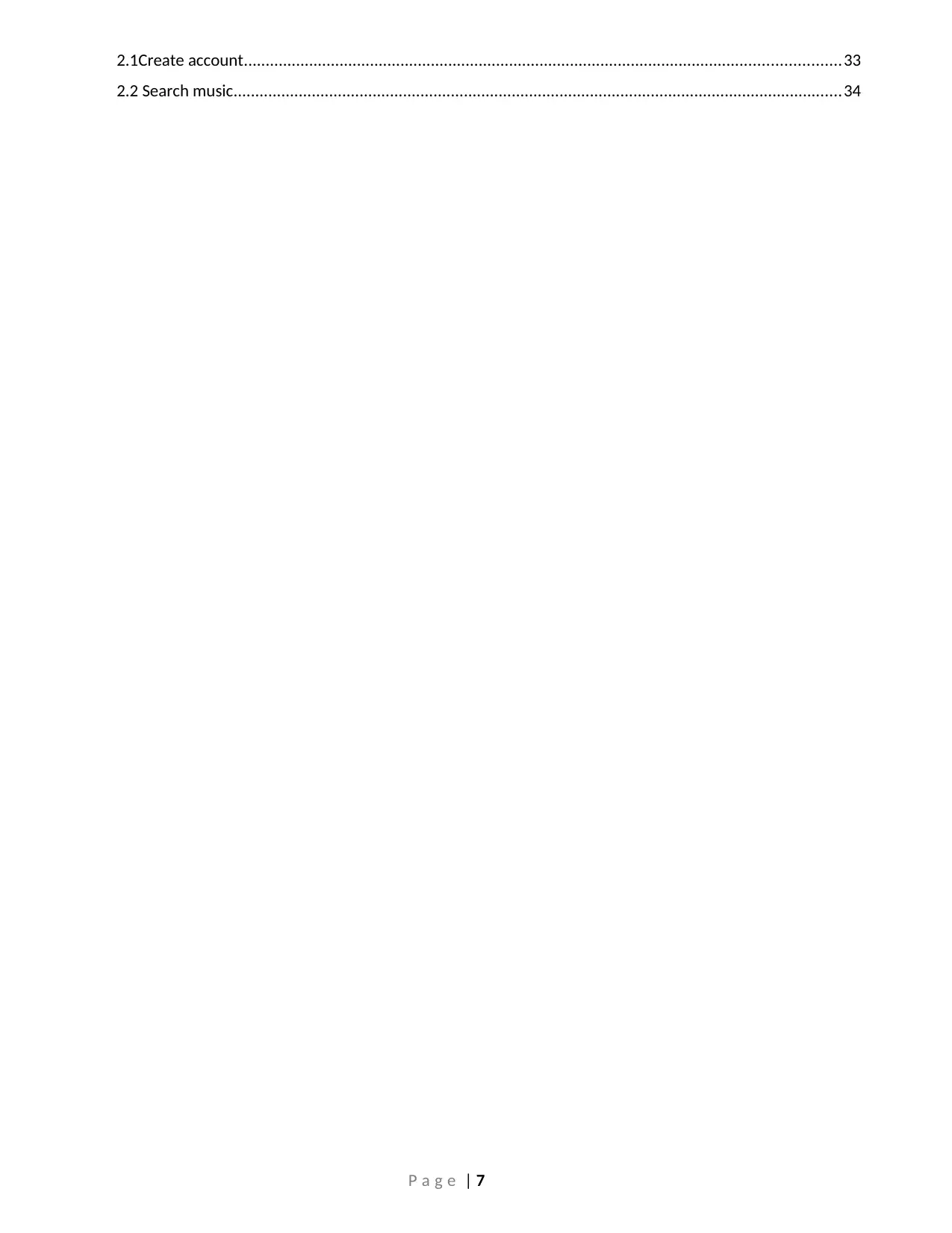
2.1Create account.........................................................................................................................................33
2.2 Search music............................................................................................................................................34
P a g e | 7
2.2 Search music............................................................................................................................................34
P a g e | 7
⊘ This is a preview!⊘
Do you want full access?
Subscribe today to unlock all pages.

Trusted by 1+ million students worldwide
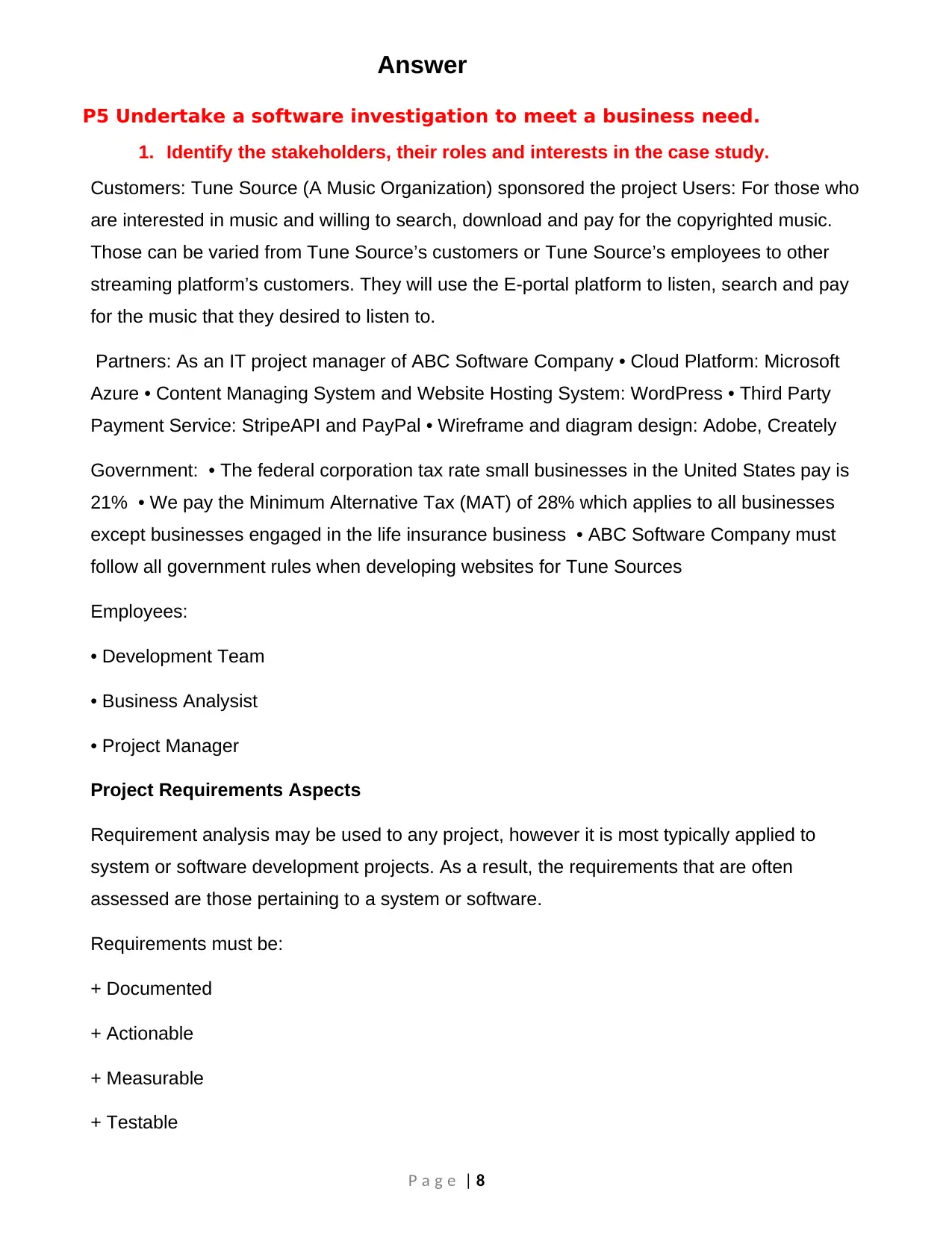
Answer
P5 Undertake a software investigation to meet a business need.
1. Identify the stakeholders, their roles and interests in the case study.
Customers: Tune Source (A Music Organization) sponsored the project Users: For those who
are interested in music and willing to search, download and pay for the copyrighted music.
Those can be varied from Tune Source’s customers or Tune Source’s employees to other
streaming platform’s customers. They will use the E-portal platform to listen, search and pay
for the music that they desired to listen to.
Partners: As an IT project manager of ABC Software Company • Cloud Platform: Microsoft
Azure • Content Managing System and Website Hosting System: WordPress • Third Party
Payment Service: StripeAPI and PayPal • Wireframe and diagram design: Adobe, Creately
Government: • The federal corporation tax rate small businesses in the United States pay is
21% • We pay the Minimum Alternative Tax (MAT) of 28% which applies to all businesses
except businesses engaged in the life insurance business • ABC Software Company must
follow all government rules when developing websites for Tune Sources
Employees:
• Development Team
• Business Analysist
• Project Manager
Project Requirements Aspects
Requirement analysis may be used to any project, however it is most typically applied to
system or software development projects. As a result, the requirements that are often
assessed are those pertaining to a system or software.
Requirements must be:
+ Documented
+ Actionable
+ Measurable
+ Testable
P a g e | 8
P5 Undertake a software investigation to meet a business need.
1. Identify the stakeholders, their roles and interests in the case study.
Customers: Tune Source (A Music Organization) sponsored the project Users: For those who
are interested in music and willing to search, download and pay for the copyrighted music.
Those can be varied from Tune Source’s customers or Tune Source’s employees to other
streaming platform’s customers. They will use the E-portal platform to listen, search and pay
for the music that they desired to listen to.
Partners: As an IT project manager of ABC Software Company • Cloud Platform: Microsoft
Azure • Content Managing System and Website Hosting System: WordPress • Third Party
Payment Service: StripeAPI and PayPal • Wireframe and diagram design: Adobe, Creately
Government: • The federal corporation tax rate small businesses in the United States pay is
21% • We pay the Minimum Alternative Tax (MAT) of 28% which applies to all businesses
except businesses engaged in the life insurance business • ABC Software Company must
follow all government rules when developing websites for Tune Sources
Employees:
• Development Team
• Business Analysist
• Project Manager
Project Requirements Aspects
Requirement analysis may be used to any project, however it is most typically applied to
system or software development projects. As a result, the requirements that are often
assessed are those pertaining to a system or software.
Requirements must be:
+ Documented
+ Actionable
+ Measurable
+ Testable
P a g e | 8
Paraphrase This Document
Need a fresh take? Get an instant paraphrase of this document with our AI Paraphraser
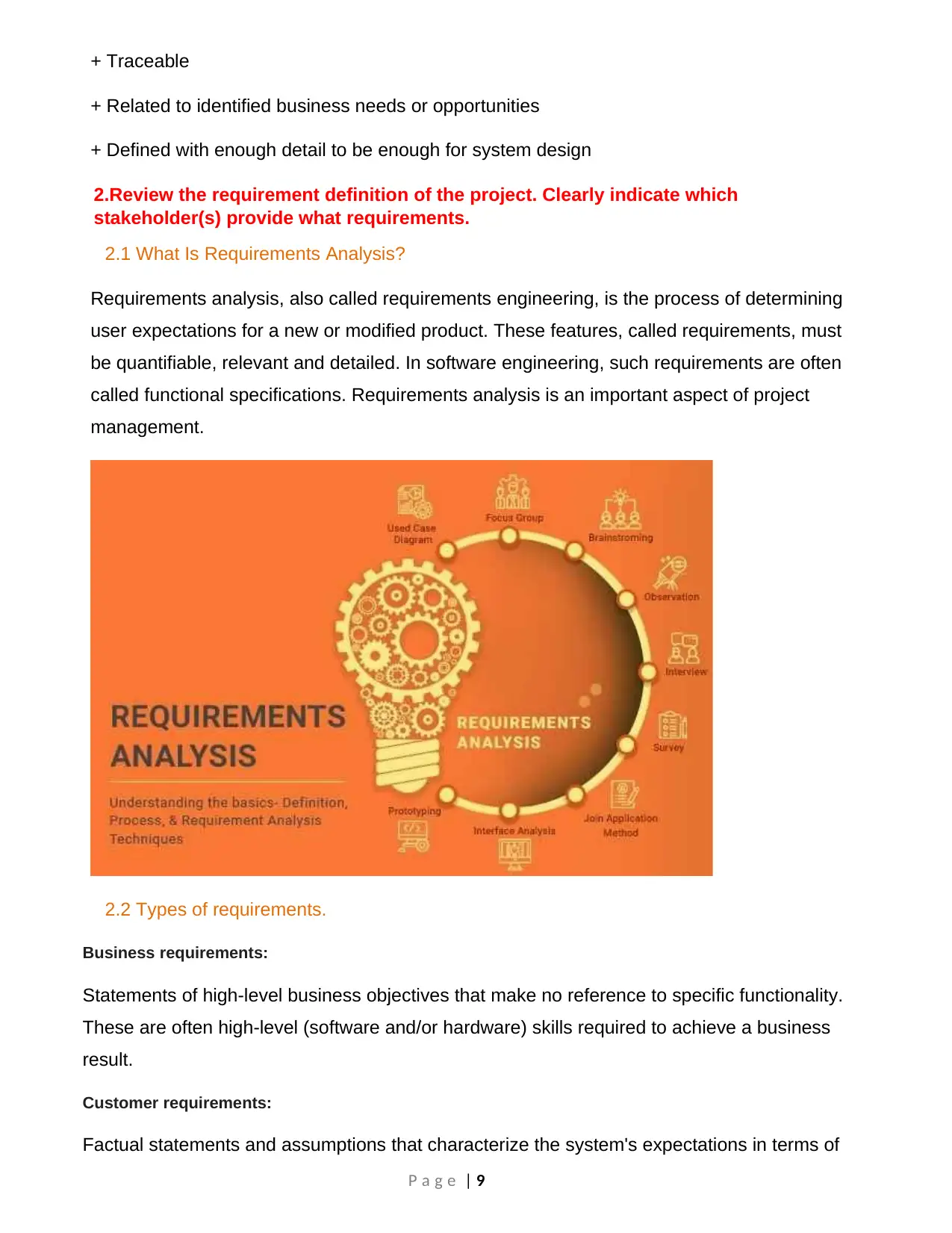
+ Traceable
+ Related to identified business needs or opportunities
+ Defined with enough detail to be enough for system design
2.Review the requirement definition of the project. Clearly indicate which
stakeholder(s) provide what requirements.
2.1 What Is Requirements Analysis?
Requirements analysis, also called requirements engineering, is the process of determining
user expectations for a new or modified product. These features, called requirements, must
be quantifiable, relevant and detailed. In software engineering, such requirements are often
called functional specifications. Requirements analysis is an important aspect of project
management.
2.2 Types of requirements.
Business requirements:
Statements of high-level business objectives that make no reference to specific functionality.
These are often high-level (software and/or hardware) skills required to achieve a business
result.
Customer requirements:
Factual statements and assumptions that characterize the system's expectations in terms of
P a g e | 9
+ Related to identified business needs or opportunities
+ Defined with enough detail to be enough for system design
2.Review the requirement definition of the project. Clearly indicate which
stakeholder(s) provide what requirements.
2.1 What Is Requirements Analysis?
Requirements analysis, also called requirements engineering, is the process of determining
user expectations for a new or modified product. These features, called requirements, must
be quantifiable, relevant and detailed. In software engineering, such requirements are often
called functional specifications. Requirements analysis is an important aspect of project
management.
2.2 Types of requirements.
Business requirements:
Statements of high-level business objectives that make no reference to specific functionality.
These are often high-level (software and/or hardware) skills required to achieve a business
result.
Customer requirements:
Factual statements and assumptions that characterize the system's expectations in terms of
P a g e | 9
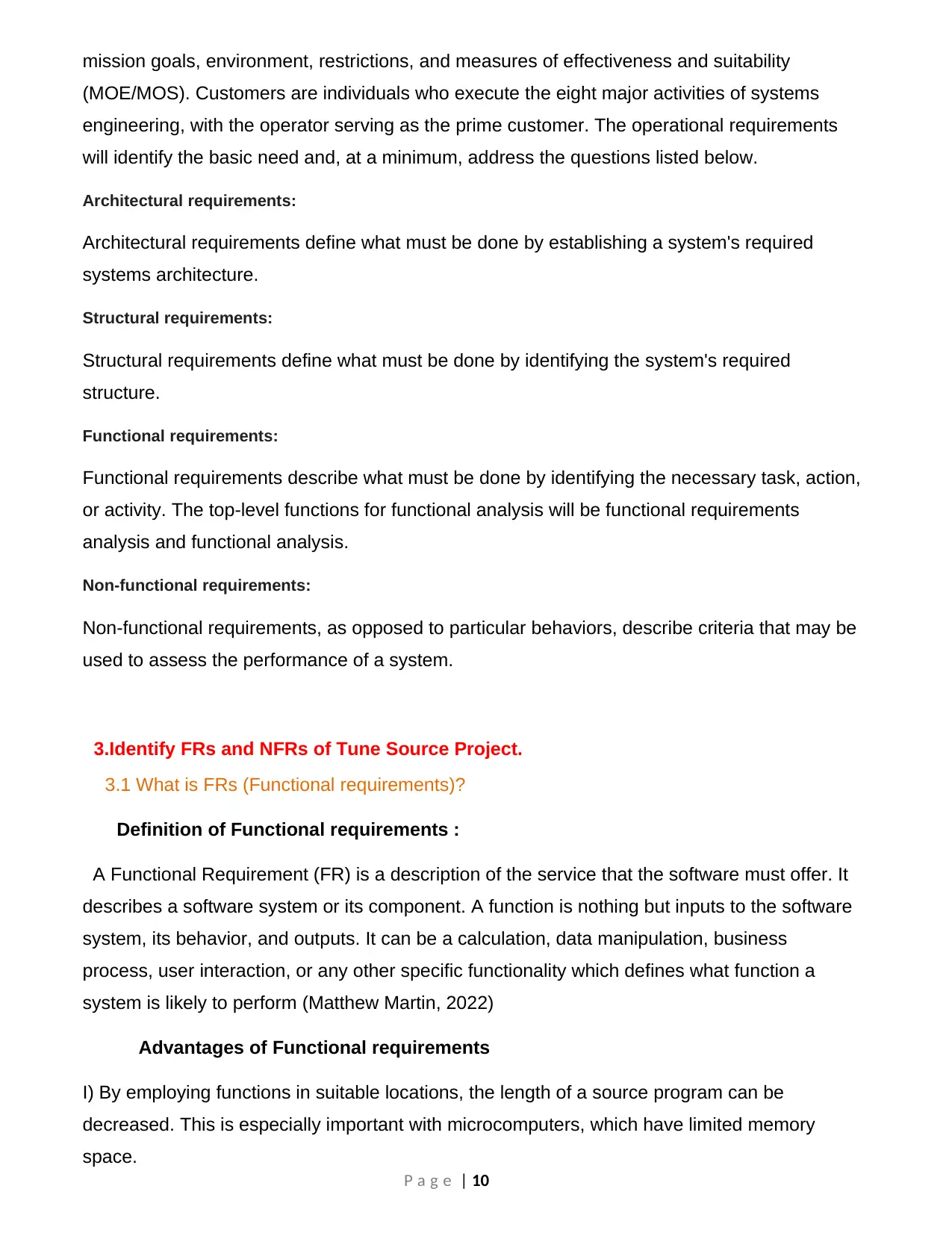
mission goals, environment, restrictions, and measures of effectiveness and suitability
(MOE/MOS). Customers are individuals who execute the eight major activities of systems
engineering, with the operator serving as the prime customer. The operational requirements
will identify the basic need and, at a minimum, address the questions listed below.
Architectural requirements:
Architectural requirements define what must be done by establishing a system's required
systems architecture.
Structural requirements:
Structural requirements define what must be done by identifying the system's required
structure.
Functional requirements:
Functional requirements describe what must be done by identifying the necessary task, action,
or activity. The top-level functions for functional analysis will be functional requirements
analysis and functional analysis.
Non-functional requirements:
Non-functional requirements, as opposed to particular behaviors, describe criteria that may be
used to assess the performance of a system.
3.Identify FRs and NFRs of Tune Source Project.
3.1 What is FRs (Functional requirements)?
Definition of Functional requirements :
A Functional Requirement (FR) is a description of the service that the software must offer. It
describes a software system or its component. A function is nothing but inputs to the software
system, its behavior, and outputs. It can be a calculation, data manipulation, business
process, user interaction, or any other specific functionality which defines what function a
system is likely to perform (Matthew Martin, 2022)
Advantages of Functional requirements
I) By employing functions in suitable locations, the length of a source program can be
decreased. This is especially important with microcomputers, which have limited memory
space.
P a g e | 10
(MOE/MOS). Customers are individuals who execute the eight major activities of systems
engineering, with the operator serving as the prime customer. The operational requirements
will identify the basic need and, at a minimum, address the questions listed below.
Architectural requirements:
Architectural requirements define what must be done by establishing a system's required
systems architecture.
Structural requirements:
Structural requirements define what must be done by identifying the system's required
structure.
Functional requirements:
Functional requirements describe what must be done by identifying the necessary task, action,
or activity. The top-level functions for functional analysis will be functional requirements
analysis and functional analysis.
Non-functional requirements:
Non-functional requirements, as opposed to particular behaviors, describe criteria that may be
used to assess the performance of a system.
3.Identify FRs and NFRs of Tune Source Project.
3.1 What is FRs (Functional requirements)?
Definition of Functional requirements :
A Functional Requirement (FR) is a description of the service that the software must offer. It
describes a software system or its component. A function is nothing but inputs to the software
system, its behavior, and outputs. It can be a calculation, data manipulation, business
process, user interaction, or any other specific functionality which defines what function a
system is likely to perform (Matthew Martin, 2022)
Advantages of Functional requirements
I) By employing functions in suitable locations, the length of a source program can be
decreased. This is especially important with microcomputers, which have limited memory
space.
P a g e | 10
⊘ This is a preview!⊘
Do you want full access?
Subscribe today to unlock all pages.

Trusted by 1+ million students worldwide
1 out of 37
Related Documents
Your All-in-One AI-Powered Toolkit for Academic Success.
+13062052269
info@desklib.com
Available 24*7 on WhatsApp / Email
![[object Object]](/_next/static/media/star-bottom.7253800d.svg)
Unlock your academic potential
Copyright © 2020–2025 A2Z Services. All Rights Reserved. Developed and managed by ZUCOL.





